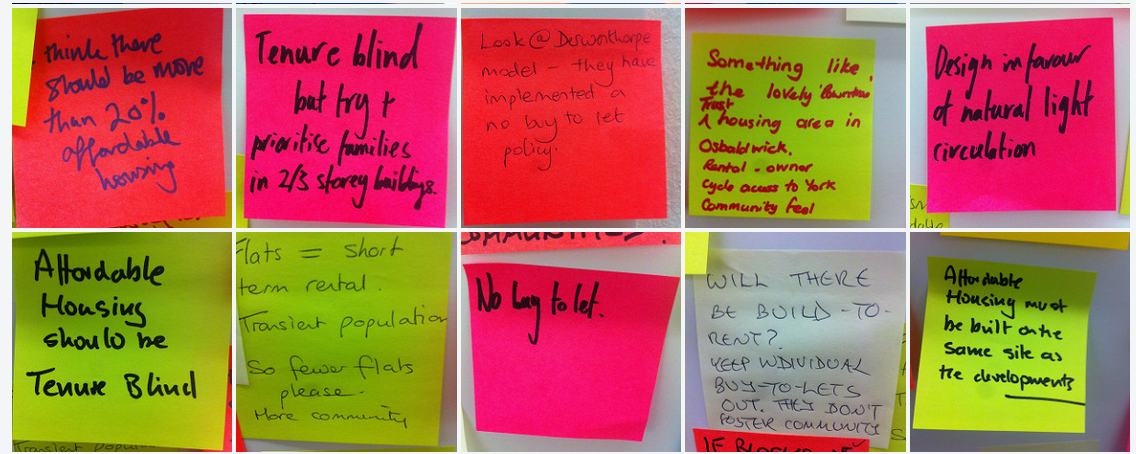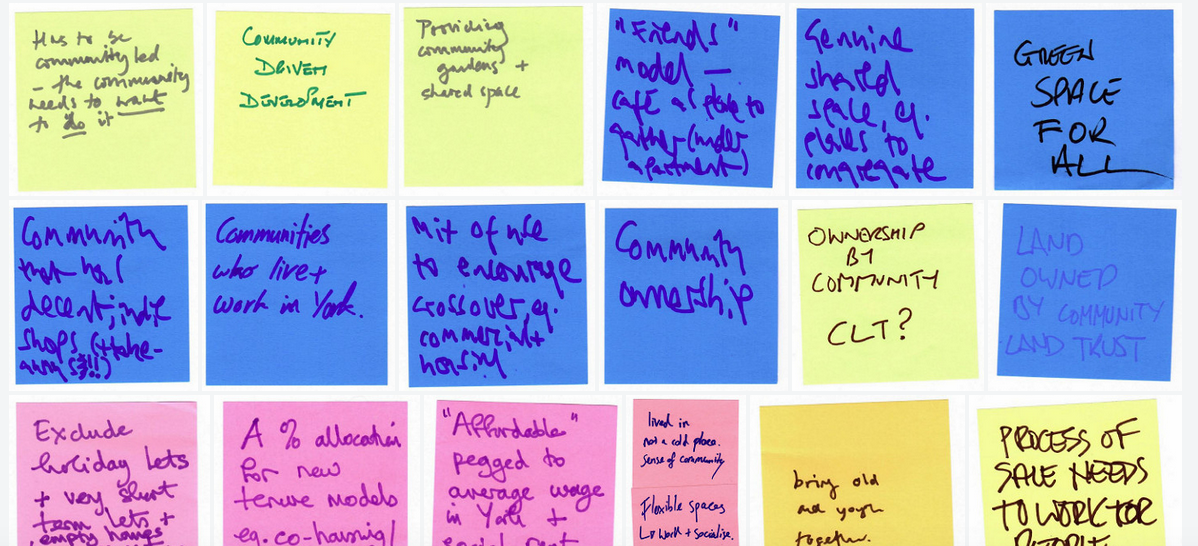
During Week 2 of the Festival of York Central we have focussed on the nature of home and the experience of living on a future York Central, looking at the kind of homes and indeed the kind of community that people want to see.
We’ve gathered information through social media and through a range of events:-
1. Meeting with Helen Fielding of Homes England
2. Housing Histories, Housing Futures workshop at York Explore
3. Forever Affordable: Community-Led Housing workshop
4. Quality in Housing: the Rowntree legacy at Derwenthorpe walkabout
5. Understanding housing density with Dr Roger Pierce walkabout and workshop
6. Feels Like Home, family drop in workshop
7. Post it notes through the exhibition and events
8. Pulling Together the Week’s Conversations – public workshop (with The Life Sized City film screening)
In addition, tagging of comments from previous events has allowed us to put responses from the week’s events in a broader context of overall comments and questions.
Here are the main issues and comments:-
An overall theme is emerging. This is to say a broadly cautious ‘yes’ to high density housing and commercial uses. But, and it is a big but, a form of ‘social contract’ needs to be set up with the people of York. To put it another way, there is a deal to be negotiated here. One that accepts higher density housing on the condition York Central deals with affordability, builds a mixed and diverse community, is high quality for all and makes the benefits of density really work for future residents. Here are the key briefing ideas.
Affordable – and Forever Affordable
The vast majority of the post it notes contributed at the exhibition relating to homes make this point: they need to be affordable, affordable needs mean actually affordable (not only the policy definition 80% market cost) and they need to not just be affordable to start off with but perpetually. This may well require, as discussed at the Forever Affordable event, a locally specific definition of affordable linked to earnings not the market. Many questioned 20% as a minimum and sought a higher percentage.

Community – what is it and how to make it work?
‘Home’ doesn’t end at the front door. There was a desire for home to mean the wider community too. We started to describe what we mean by community, prompted by the discussion with Helen Fielding, Homes England, at the Forever Affordable event and continued the line of discussion through the events. A mixed community was often welcomed – though some warning bells were sounded by others. More work on this is needed (further meetings and discussions are to be held at Derwenthorpe where 40% is affordable, amongst others).
Family homes, Inclusive and lifetime homes
There was a recognition that we too often tend to think of ‘family homes’ as a house with a yard or garden and that maybe we need to look more closely at what makes for good apartment living for families. There are examples of multi-storey family homes in London and elsewhere in the UK (plus a lot more in mainland Europe) so feedback will be sought. Similarly there was an interest that as many as possible of the homes work for disabled people and can be designed as lifetime homes.
Height+Quality (Or, how to encourage downsizers)
‘It can be high, but it needs to be great’
While there is some concern about height and what the proposed total housing number and density might mean, there is a very strong feeling that height can be ok if it is very high quality. That is, the flat is of a good size with high ceilings, is well insulated for noise between flats and has good sized balconies. Good apartment living also requires very serious maintenance and ongoing investment, this would need to be considered in service charges and how this works for the affordable housing would need to be seriously explored. One possible line of inquiry is that very good quality flats might well encourage downsizers and free up family-sized homes elsewhere – but that the quality is key (more on how to achieve this below).
Density+Benefits: Work the social contract
‘We don’t want it to be ghost town like Hungate. If it’s going to be dense, it needs to be alive’
Through the exploration of density, it became clear that a ‘social contract’ issue might be to really make the benefits of high density living clear and real. High density should for example mean: good local shops nearby and walkable; excellent public transport network (such as a tram or similar permanent and reliable system); close to gyms, childcare, schools and other community facilities. The most popular alternative name for York Central so far is ‘New York’: if we’re going to have high densities how do we really ensure the benefits of living in urban areas?
Mixed Uses
‘We need to stop looking at plans and think 3D’
Many have questioned the need to zone commercial development away from housing and have asked whether a vibrant urban area needs mixed uses. One quote was to ‘think 3D’ – suggesting there might be benefits in having shops, social and commercial at ground level, offices at first floor and flats above to avoid the ‘ghost town’ effect and drive life in the public realm.
High environmental standards…for all
There have been many comments supporting “highest possible” environmental standards. Going beyond current Building Regulation minimum standards would allow higher standards of comfort (see “it can be high, but it needs to be great” above), higher standards of sound separation from the surrounding railways (triple-glazed windows and mechanical ventilation reducing the need to open windows) and would reduce the likelihood of fuel poverty for those on low incomes. Costs would be raised slightly to cover this investment, but with land ownership being with public bodies, this is seen as a rare opportunity, and would also create a distinctive image for the development.
Make use of roofs
Gardens don’t have to be on the ground – reflecting also the Open Spaces work we did last week, people thought access to roofs, for gardens, for solar panels, made sense. And took advantage of the height for good views.
How to make this happen – the next steps:
• Policy, governance and funding levers: Alongside developing this initial open brief, we were able to start to explore some of the policy, governance and funding possibilities to make this happen. We will be following up with Homes England on affordable and community-led housing, and developing discussion on what is true affordability. The case for a Community Land Trust has also been voiced – where public elements of the proposal, including public realm, community facilities and potentially affordable housing, could be invested into a Community Land Trust, protecting ownership and status.
• Evoking ‘community’: Drawing on discussion started this week, we’ll start developing an open brief for a vibrant York Central community.
• Understanding the housing challenges: Based on an idea that emerged at the Forever Affordable event, we’ll be seeking people who have stories to share about their housing challenges and how York Central might offer an answer.
• Co-design? Clearly there is an argument that to get quality – and to really attract families, disabled people or downsizers for example – the housing could be usefully co-designed. We’ll be looking for people interested in exploring this idea further.